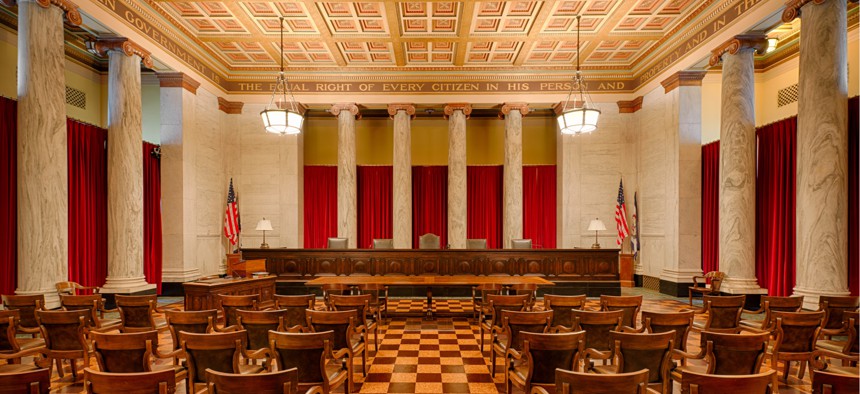It's Time To Stop Electing Judges

The West Virginia State Supreme Court Chamber has been roiled by impeachments this year. Nagel Photography / Shutterstock.com

Connecting state and local government leaders
COMMENTARY | Many states started electing judges to reduce political influence. In 2018, states need to rethink their approach.
If the Supreme Court nomination of Brett Kavanaugh proved that the federal model for appointing judges is deeply flawed, wait until you hear about the 38 states that currently choose their top judges through elections.
In a perfect world, electing judges might not be such a big problem. In fact, many states started electing judges over a century ago to get those decisions out of smoke-filled rooms and reduce political influence over judges. But our current election system is overrun with wealthy special interests that air “dark money” attack ads to get their preferred candidate on the court. As a result, states are picking judges based not only on votes, but based in part on how much anonymous financial support will come to their aid.
This is a worst-case scenario for ensuring fair and impartial courts: the political pressures on judges remain, and the public doesn’t get the full picture. The conflicts of interest that arise when big campaign supporters appear in cases before the judges they supported can create the appearance—and sometimes the reality—of bias. During the Kavanaugh confirmation, we saw all sides crying foul on the big-money ad pushes for and against his nomination, but at the state level, this is often the norm.
And the problem is only getting worse. In the 2015-16 election cycle, 27 justices were elected in races where campaigns spent over a million dollars to win a seat on the court—up from a previous record of 19. Today, 20 states have a sitting justice who has been through a million-dollar race. We can’t expect this problem to go away on its own. What’s worse, often this money funds TV ads that are misleading at best, and may even be having an impact on how judges rule on the bench.
This year has been no different. Not even counting “dark money” independent spending, candidates for a spring Supreme Court election in Wisconsin collected over $2 million in contributions. In Alabama, three Supreme Court elections on the ballot in November have already attracted more than $5 million in total contributions. In Michigan’s judicial elections, the Republican Party is reportedly undercutting the campaign of a justice it endorsed, but who ruled against the party’s position in a high-profile case, by leaving her off campaign materials. A clearer demonstration of why partisan big-money elections are a threat to judicial independence is hard to imagine.
So-called, “dark money” plays an especially pernicious role. In the 2015-16 election cycle, 40 percent of election spending came from outside groups, the overwhelming majority of which was non-transparent. This fall opaque groups are already spending millions in Arkansas, West Virginia, North Carolina, and Michigan. The public has no way to know the identity of many of these donors: they could be an insurance company needing one more vote to escape a large payout, or a coalition of ideological and industry groups protecting a friendly court majority.
But here is the good news: there is a better model for choosing judges. It’s a publicly accountable appointment system, which many states use as part of a “merit selection” system. The accountable appointment system works like a job interview. A diverse nonpartisan commission made up of state residents, members of the legal community, and other appointees review each potential justice on their qualifications and impartiality. The top candidates are passed along to the Governor and the Governor must choose one of these candidates for the job.
As always, the devil is in the details with accountable appointment systems. In Florida, for example, the Governor has overwhelming and partisan control over the members of the Judicial Qualification Commission. Luckily, the Florida legislature could easily fix this problem now that it is coming increasingly to light. Many states have best practices to share for structuring an accountable appointment system — all highlighted in the Brennan Center’s just-published best-practice guide.
There are also ways to run judicial elections that can at least mitigate some of their worst problems. Prompt disclosure of all campaign spending and fair rules for when judges must step aside from hearing cases involving campaign supporters are just two common-sense ways states could make their judicial elections more fair. Having elected judges serve for just one lengthy term will also ensure that, at least once they reach the bench, judges won’t be thinking about the political and financial support they need in their next election. Everyone in any election deserves to know who is trying to influence their votes, and everyone appearing in court deserves to know that their judge is unbiased.
In the end, however, it’s best that states move away from judicial elections altogether. The U.S. is nearly unique in using popular elections for the third branch of government. And nowhere else that elects judges have wealthy special interests so undermined the purpose of popular elections.
The stakes couldn’t be higher. Our rights and liberties are on the line in who sits on the state courts that hear 95 percent of all cases. It’s 2018, and it's time to take big-money out of judicial selection and work to get the most fair, impartial, diverse, and qualified judges onto our courts.
Douglas Keith is Counsel in the Brennan Center for Justice’s Democracy Program.
NEXT STORY: Thousands of Pennsylvania Hospitalizations Related to Opioid Use




